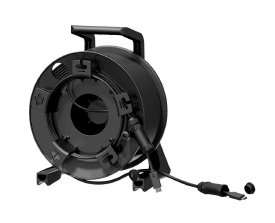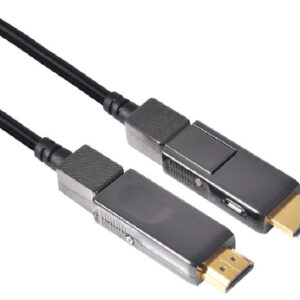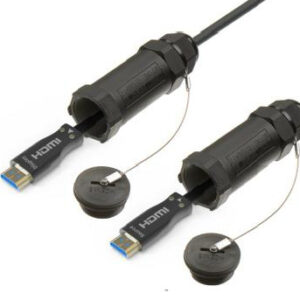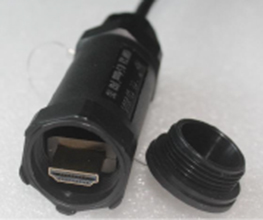Showing all 7 results
-
Armored HDMI 2.0 Hybrid Type A to A AOC
Price range: $144.00 through $504.00 -
Armored HDMI 2.0 Hybrid Type A to D AOC
Price range: $164.00 through $524.00 -
Armored HDMI 2.0 Hybrid Type D to D AOC
Price range: $184.00 through $544.00 -
Armored HDMI 8K Hybrid Type AM to AM AOC
Price range: $125.00 through $535.00
Plugsters Armored HDMI Hybrid Cables are the answer for long reach HDMI interconnection solutions. Our cables support an HDMI Data Rate of 6Gbps per channel with a total 18Gbps. They are a lightweight flexible hybrid cable with an ultra-small long-term bending radius of 45mm. With our embedded advanced optical engine these HDMI Hybrid Cables provide full HDMI signal integrity. They support up to 100M maximum length “Plug and Play. No external power required!
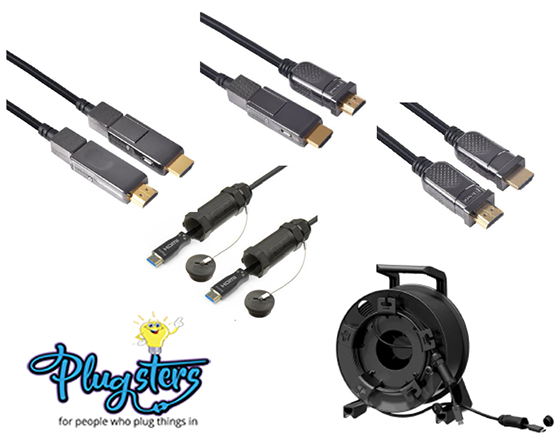
Armored HDMI Hybrid Cable Basics
Armored HDMI Hybrid cables are much stronger and tougher than common cables, which are designed to withstand crush, pressure, and rodent issues. They possess high flexibility and durability when used in harsh environments or limited space.
When it comes to unarmored and armored fiber optic cables comparison, the distinctive difference lies in the outer protective layer. Precisely speaking, the armoring material doesn’t have to be metal, which can be fiber yarn, glass yarn, polyethylene, etc. The additional outer protective layer for optical cable makes the armored cable special, so the armored cables will be installed in locations that may expose to mechanical damages, while unarmored cables are normally used for control systems.

Armored HDMI Hybrid cables possess several layers to secure the cable. The plastic outer jacket provides protection against rodents, abrasion, and twist. Then the light steel tube between the optic fibers and the outer jacket offers better protection to the fibers in the center. And the Kevlar is placed inside the outer jacket to cover the steel tube. The picture below presents a basic structure of armored cable, which may change accordingly to different usage occasions.
Armored HDMI Hybrid cables possess several layers to secure the cable. The plastic outer jacket provides protection against rodents, abrasion, and twist. Then the light steel tube between the optic fibers and the outer jacket offers better protection to the fibers in the center. And the Kevlar is placed inside the outer jacket to cover the steel tube. The picture below presents a basic structure of armored cable, which may change accordingly to different usage occasions.

Armored HDMI Hybrid Cable Types
The armored fiber cables can be classified into several types. Nonetheless, it includes the type of metal tube within the cable. In addition, the installation methods of the cable, and the specific applications.
Classification According to Metal Tube
Optic cable can be divided into two types according to the metal tube. This includes, interlock armored fiber cable and corrugated armored cable. Interlocking armor is an aluminum armor that is helically wrapped around the cable and found in indoor and outdoor cables, which offers ruggedness and superior crush resistance. Corrugated armor is a coated steel tape folded around the cable longitudinally, which can be found in outdoor cables and offers extra mechanical and rodent protection. Both armored fiber cables enable installation in the most hazardous areas, including environments with excessive dust, oil, gas, moisture, or even damage-causing rodents.

Classification According to the Installation Method
As mentioned before, there is a strong metal armored tube inside the armored fiber cable. Therefore, the termination of the armored fiber cable is more difficult than that of standard fiber optic cables. Field-terminated armored fiber cables have better performances in some outdoor applications, while pre-terminated ones are adopted by many installers for indoor applications considering quality transmission and time-saving factors.
Furthermore, the pre-terminated armored fiber cables provided by the market are mainly armored fiber patch cable and armored fiber trunk cable: the former is stronger and more flexible than the traditional fiber patch cable, while the latter is a length of armored fiber cable with several legs on each end terminated with fiber optic connectors.
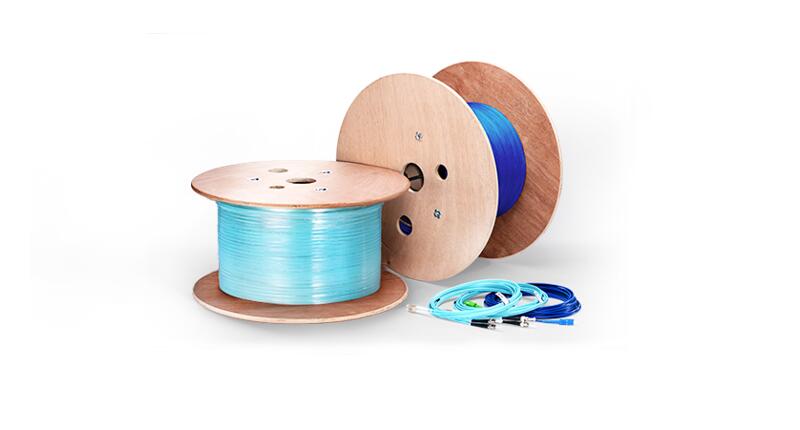
Classification According to Application
Armored fiber cable is for indoor and outside plant (OSP) applications. Both loose-buffered and tight-buffered armored fiber cable can fit indoor and outdoor applications. Accordinly, loose-buffered cables are used in outdoor applications.
About Indoor Armored Fiber Cable. The armored cable used for indoor applications often consists of tight-buffered or loose-buffered with strength members and an inner jacket. The inner jacket is commonly surrounded by a spirally-wrapped interlocking metal tap armor. Typical indoor armored fiber cable types include GJFJV, GJFJZY, GJFJBV, GJFJBZY, GJFDBV, and GJFDBZY. Fiber optic communication technology is developing quickly. Conversely, the trend of FTTX, the demand for installing indoor fiber optic cables between and inside buildings is fast-growing.
Outdoor Armored Fiber Cable. It is known that armored cable for outdoor is designed to ensure operation safety in complicated outdoor environments. Most of them are loose buffer designs. Light armor and heavy armor are the two versions of outdoor armored fiber optic cable. Heavy armored cable is wrapped in a wire circle that will protect the fibers from gnawing animals and damages.
Armored HDMI Hybrid Cable Installation Guide
Armored fiber optic cable caters to both the rigorous environment of the outdoors. Despite the numerous benefits armored fiber cable retains, it also yields some inconvenience to bond and ground the cable. To handle the problem that may occur during the installation, wisely perform the following steps.
- Bend Cable. Bend the armored cable about 10 inches from its end and squeeze with your hand until the coils of the armor come apart. If you can’t do this by hand, use pliers, or employ another cutting method.
- Twist Cable. Firmly grip the armored cable on each side of the cut and twist until the split-apart armor coil pops out, away from the wires. Use two pairs of pliers if you can’t do this by hand.
- Cut Exposed Coil—Using side cutters, cut the exposed coil of sheathing. You may have to grab the coil with the side cutters and work it back and forth to open and make the cut.
- Cut the Wires—If you are cutting a piece to length, slide back the sheathing and cut through the wires. Otherwise, slide the waste piece off and throw it away.
- Remove Excess—Cut off any sharp points of sheathing using side cutters. Remove the paper wrapping and any thin plastic strips.
Summary
Contrarily, armored fiber cable presents a premium solution to secure the network by protecting fiber links. This is specified as the primary backbone due to its distinct advantages for space efficiency. It also provides lower cost of materials and installation, as well as less risk of downtime and damage.

